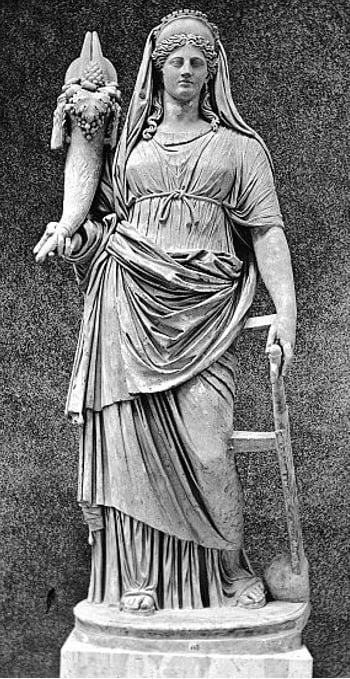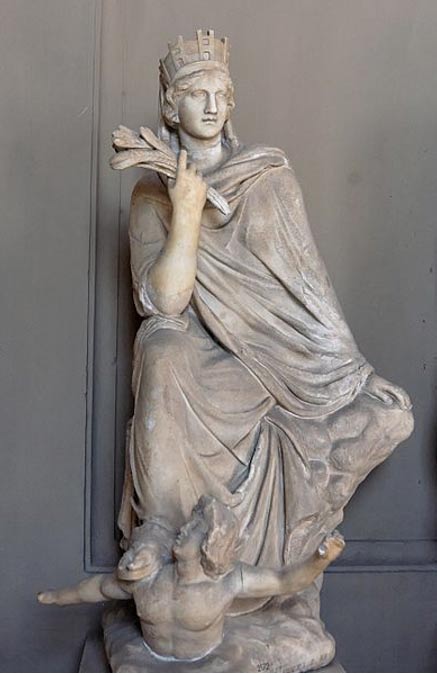
The Goddess Tyche as Lady Luck
Throughout time, humanity has given great consideration to elements believed to bring good fortune our way. The more people believe that they can control unpredictable forces, the more they trust they master their destinies. There have been various representations of this as we moved through history, and many even now attribute their luck to carrying a rabbit's foot, blowing on dice before tossing them, or wearing a "lucky" color to a job interview.
The Greek Goddess Tyche once stood as a symbol of luck and chance for many ancient Greeks. Later evolving into not only a guiding divinity for the individual, but a broader personification of protection over ancient cities (and even nations), her popularity spread over massive geographical regions.
She became synonymous with other deities, such as the Roman Fortuna, as well as Cebele, Nemesis, Isis, Demeter, Astarte, and sometimes (although some believe erroneously) with one of the Fates (Moirai). Tyche’s image has been depicted in many ways, with varying features of emblematic adornment. The most remarkable stories and artifacts, and their accompanying historical significance will be explored.

Engraving of Tyche as ‘Fortuna’ with the Wheel of Fate and other symbols. (Public Domain)
Tyche in Literature
Some of the earliest traces of Tyche, whose name translates to mean 'luck', 'chance', or 'fortune', date back to the poet Pindar of the 5th century BC, who refers to her as "a savior goddess," other indications of her influence are found in the works of Hesiod in the 7th century BC.
Hesiod's 'Theogony' spoke of Tyche as being a daughter of the Titans Oceanus and Tethys - conflicting with older claims of Zeus being her father. Other Hellenistic authors disagreed, claiming she was the child of Hermes and Aphrodite.
Her name, both as a deity and as a later unifying concept, is seen in multiple other written pieces, most notably attributed to Plato and Aesop's Fables. In later versions of her character, she is more widely associated with good luck (as in depictions of Agathe Tyche or with a husband, Agathos Daimon, or "good spirit") than her earlier temperamental and erratic depiction as "blind luck" or "chance."

Engraving of Nemesis or Good Fortune. (1502) By Albrecht Dürer. (Public Domain)
- Celestial Goddess Selene: The Star of the Night
- The Three Fates: Destiny’s Deities of Ancient Greece and Rome
- The Intriguing Origins of Aphrodite
The Tychaion
Particularly after the expansion of Alexander the Great's massive empire over several conquests (and subsequently his successors'), it appeared emphatically that luck and chance favored some over others. It was during this period that Tyche’s value became far more extensive, with altars to Tyche-Fortuna being erected in cities and numerous military bath-houses. Her likeness can be found on assorted antiquities, including coins, architecture, jewelry/amulets, and shrines, and she eventually came to be utilized skillfully by ruling governments to unify diverse ethnicities and cults. One of the most renowned and frequently replicated of pieces dedicated to the goddess is known as ‘The Tychaion.’
Although the original Tychaion, created by Eutychides of Sicyon, is lost, it has been replicated countless times. Well-known duplicates can be viewed at the Vatican and the Louvre, among other locations.
Constructed in reverence of Tyche's favor over the city of Antioch, the original statue was unique for the period because it had detailing on all sides. It was first built in stunning bronze, with symbols that include: ears of grain held in her hand to represent the fertility of city crops, her foot pressed down upon a swimmer to represent the Orontes River of the region, and her position sitting on a rock to represent Mount Sipylus. Her mural crown indicates this piece served as a representational statue over a city (Antioch); later replicas and representations wore the mural crown to signify this as well.
The Tyche of Antioch. Roman copy in marble after the original Greek bronze by Eutychides of the 3rd century BC. Vatican Museums. (Public Domain)
More Iconography with Tyche
Other portrayals of her image showed altering iconographical adornments, often chosen for their significance in the region to which it was to be appointed. Some of these show Tyche (or the interchangeable Fortuna) blind-folded, depicting 'blind fate,' or blind justice, being distributed without reason and a cornucopia spilling coins of wealth. Others are holding a cornucopia overflowing with fruits, signifying the abundance of crops for the region depicted, and/or an infant - Plutus – which signified wealth.

Statue of Tyche with Plutus. Istanbul Archeological Museum. (CC BY SA 4.0)
In other representations, Tyche has a rudder or plough shaft (or two, demonstrating her steering of fortune one way for some, and a different way for others) in addition to a cornucopia. Still more images depict her holding a cornucopia with a slightly taller and differently-sculpted mural or turret crown.

Tyche holding a cornucopia. Photo from the collections of the Brooklyn Museum. (Public Domain)
Later iconography was combined purposely by Romans - such as the Roman Fortuna's rudder and wheel (balance) or globe (signifying Roman fortune being applied via naval or sea conquest over the world), or to declare the destiny of the Roman Empire as powerful over many regions.

Allegory of Fortune. (circa 1520-1530) Musée des Beaux-Arts de Strasbourg. (Public Domain)
- Michelangelo: A Mixture of True Talent Meeting Great Luck
- Leprechauns: At the End of the Rainbow Lies Richness for Irish Folklore
- A 1,800-year-old ring and the curse of the ‘evil eye’
Tyche and Isis
As Tyche/Fortuna's appearances grew profusely throughout the Mediterranean lands, she would, in turn, fade from focus as Christianity became more prevalent - but not before being identified with Isis. Isis is found combined with qualities of Fortuna/Tyche, and was also regarded as 'lucky' in ports - like Alexandria.
This representation of Tyche/Isis was found frequently connected with Agathos Daimon (the aforementioned 'husband' of Tyche, or 'Good Spirit') in these areas, promising a wiser form of guidance than Tyche's 'blind chance.'

Shrine figurine of Isis-Tyche-Fortuna. Walters Art Museum. (Public Domain)
Later one sees artistic links to Nemesis (aka 'Isis Nemesis' during 2nd century AD), pictured with Tyche/Fortuna. This too was meant to show a more balanced handing out of luck - to only deserving recipients.

Nemesis and Tyche/Fortuna. (Crystalinks)
Although combined with many other deities and adorned with countless varying embellishments to embody the intentions of any number of political or religious strategies, the Goddess Tyche/Fortuna has remained a figure of great interest and intrigue over many centuries.
As one passes through history, evolving hopes and desires, one pulls from her influences to manifest her ongoing presence throughout time. Let us move forward with a nod and a wink to her ancient inception, and always remember Tyche when we bid one another, "Good Luck!"
Featured Image: Fortuna (1754) by Tadeusz Kuntze. National Museum in Warsaw. Source: Public Domain
By: Kristen Callihan
References
Encyclopaedia Britannica. (2015). Tyche, Greek Goddess. Available from: http://www.britannica.com/topic/Tyche
Forest, M. Isidora. (2001) Isis Magic: Cultivating a Relationship with the Goddess of 10,000 Names. (First Edition). St. Paul, MN, Llewellyn Publications.
Lendering, J. (2010). Tyche of Antioch. Available from: http://www.livius.org/articles/concept/tyche-of-antioch/
Worscheh, H. (2014). Where Tyche and Fortuna Diverge. Helicon: The Yale Undergraduate Journal of Classics

















Comments
Very interesting read. One could also written more in detail about the relation between Tyche/Fortuna and the three Fates too.
- Moonsong
--------------------------------------------
A dreamer is one who can only find his way by moonlight, and his punishment is that he sees the dawn before the rest of the world ~ Oscar Wilde